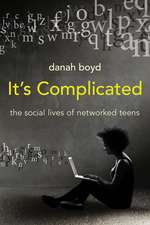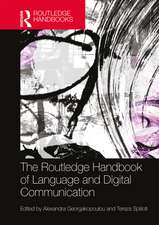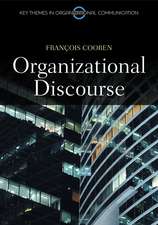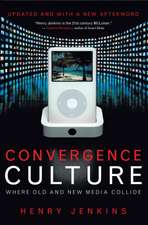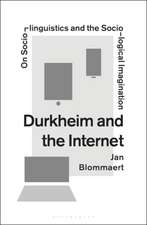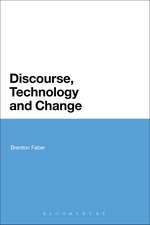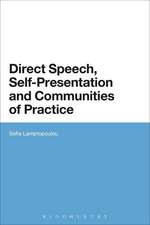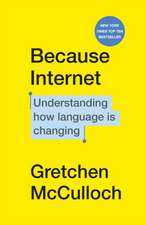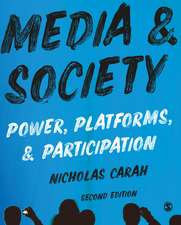Discourse of Twitter and Social Media: How We Use Language to Create Affiliation on the Web: Continuum Discourse
Autor Dr Michele Zappavignaen Limba Engleză Hardback – 22 feb 2012
| Toate formatele și edițiile | Preț | Express |
|---|---|---|
| Paperback (1) | 250.45 lei 6-8 săpt. | |
| Bloomsbury Publishing – 6 noi 2013 | 250.45 lei 6-8 săpt. | |
| Hardback (1) | 1007.20 lei 6-8 săpt. | |
| Bloomsbury Publishing – 22 feb 2012 | 1007.20 lei 6-8 săpt. |
Preț: 1007.20 lei
Preț vechi: 1171.16 lei
-14% Nou
Puncte Express: 1511
Preț estimativ în valută:
192.72€ • 201.24$ • 159.15£
192.72€ • 201.24$ • 159.15£
Carte tipărită la comandă
Livrare economică 16-30 aprilie
Preluare comenzi: 021 569.72.76
Specificații
ISBN-13: 9781441141866
ISBN-10: 1441141863
Pagini: 240
Dimensiuni: 156 x 234 x 23 mm
Greutate: 0.5 kg
Ediția:New.
Editura: Bloomsbury Publishing
Colecția Continuum
Seria Continuum Discourse
Locul publicării:London, United Kingdom
ISBN-10: 1441141863
Pagini: 240
Dimensiuni: 156 x 234 x 23 mm
Greutate: 0.5 kg
Ediția:New.
Editura: Bloomsbury Publishing
Colecția Continuum
Seria Continuum Discourse
Locul publicării:London, United Kingdom
Caracteristici
Guides
readers
on
how
to
use
in-built
tools
to
analyze
Twitter,
including
constructing
corpora.
Notă biografică
Michele
Zappavignais
an
Australian
Research
Council
(ARC)
Postdoctoral
Fellow
in
Linguistics
at
the
University
of
Sydney,
Australia.
Cuprins
Preface
(by
Professor
Jim
Martin)1.
Introduction:
Social
Media
and
the
Cultural
Movement
Toward
'Searchable
Talk'
2.
Social
Media
as
Corpora
3.
Evaluative
Language
Online
4.
Internet
Slang
5.
Internet
Memes
6.
Internet
Humour
and
Fail:
"The
world
is
full
of
#fail
tonight"
7.
Online
Political
Discourse
8.
Ambient
Affiliation
9.
Conclusion:
Social
Media
and
Internet
Linguistics
References
Appendices
Index
Recenzii
[This]
is
a
useful
book
that
contributes
valuable
concepts
of
"searchable
talk"
and
"ambient
affiliation"
to
the
social
media
literature.
Moreover,
it
not
only
exemplifies
its
claims
by
means
of
case
studies
on
microblogging
from
an
interdisciplinary
point
of
view
but
also
informs
its
readers
about
the
issues
to
take
into
account
while
conducting
similar
research.
In
sum,
it
is
a
great
resource
for
those
interested
in
pursuing
research
in
social
media.
The book is an interesting account of commonalities of online language. It clearly shows that users are adopting a language style that is specific to online use and that uses different signs in order to convey emotions to account for the lack of actually seeing or hearing the person that you are communicating with. The book is interesting and entertaining and some of the online inside jokes such as the "memes" are very amusing. Overall, the book is a great tool for a person interested in social networks, media and language.
The Discourse of Twitter and Social Mediais the first, large-scale linguistic analysis of the popular micro-blogging site, Twitter. Written in a lively and accessible style, this landmark study brings together cutting edge methods from corpus linguistics with the latest work in Systemic Functional Linguistics to bring to light the ways in which our talk is being reworked in Twitter. New concepts of 'searchable talk' and 'ambient affiliation' are important for understanding not only Twitter discourse, but are also relevant to the communicative practices found in social media more widely. Exploring a wide range of topics from internet memes to online humour,The Discourse of Twitter and Social Mediais useful for linguists and scholars interested in new media texts.
All in all, Zappavigna has produced a rounded piece of work from all aspects. But she has not settled there. Acknowledging that social media are a 'moving target' for scholars (Hogan & Quan-Haase 2010: 309 as cited in p. 3), she has already delved deeper into searchable talk in her most recent book (Zappavigna 2018). For certain, she will continue her substantial contribution to the field.
The book is an interesting account of commonalities of online language. It clearly shows that users are adopting a language style that is specific to online use and that uses different signs in order to convey emotions to account for the lack of actually seeing or hearing the person that you are communicating with. The book is interesting and entertaining and some of the online inside jokes such as the "memes" are very amusing. Overall, the book is a great tool for a person interested in social networks, media and language.
The Discourse of Twitter and Social Mediais the first, large-scale linguistic analysis of the popular micro-blogging site, Twitter. Written in a lively and accessible style, this landmark study brings together cutting edge methods from corpus linguistics with the latest work in Systemic Functional Linguistics to bring to light the ways in which our talk is being reworked in Twitter. New concepts of 'searchable talk' and 'ambient affiliation' are important for understanding not only Twitter discourse, but are also relevant to the communicative practices found in social media more widely. Exploring a wide range of topics from internet memes to online humour,The Discourse of Twitter and Social Mediais useful for linguists and scholars interested in new media texts.
All in all, Zappavigna has produced a rounded piece of work from all aspects. But she has not settled there. Acknowledging that social media are a 'moving target' for scholars (Hogan & Quan-Haase 2010: 309 as cited in p. 3), she has already delved deeper into searchable talk in her most recent book (Zappavigna 2018). For certain, she will continue her substantial contribution to the field.















